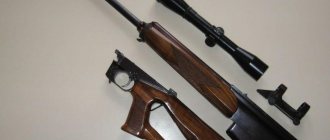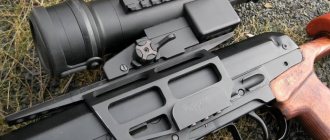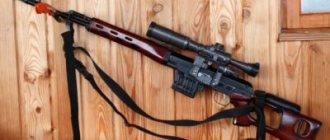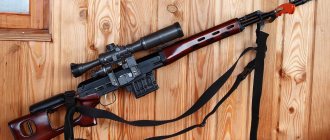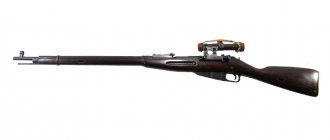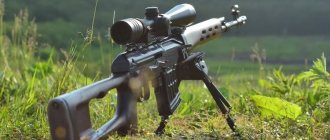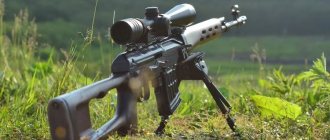The Tiger carbine is a self-loading hunting carbine, created on the basis of the Dragunov sniper rifle (SVD) and intended for hunting large and medium-sized animals. Produced in the city of Izhevsk (formerly IZHMASH). Various modifications of the Tiger carbine over the years were produced for cartridges: 7.62x54R, .308 Winchester, .30-06 Springfield and 9.3x64. Currently produced under the most popular cartridge 7.62x54R. The Tiger carbine is the most popular self-loading rifled carbine among hunters in Russia; it owes its popularity and prevalence to its unpretentiousness, simplicity of design and extreme reliability.
Story
The history of the Tiger carbine dates back to 1963, when, under the leadership of the famous firearms designer Evgeniy Dragunov, the Dragunov sniper rifle, better known under the abbreviated name SVD, was developed and put into production. The purpose of creating the SVD rifle was to create a weapon capable of replacing the sniper rifles, which were outdated by that time, based on the Mosin rifle.
In 1969, based on the SVD rifle E.F. Dragunov created the Tiger hunting carbine. The first samples were as similar as possible to the combat samples of the SVD. Until 1992, the Tiger carbine was produced in small quantities and mainly on special orders from the USSR Ministry of Defense.
Serial production of the Tiger carbine began at the Izhevsk Machine-Building Plant (Izhmash) in 1992; currently the Izhmash plant is part of Kalashnikov Concern JSC.
In 1996, the first modification of the carbine was created, which received the designation “Tiger-01”; it was designed for sale on the American market and was adapted to its requirements.
In all subsequent years, the plant launched into production new modifications of the Tiger carbine, which differ from each other in the type of stock, barrel length and other design differences. In addition to the production of the Tiger carbine chambered for 7.62x54, the plant also mastered the production of carbine chambered for .308 Win, .30-06 Sprg and 9.3x64 mm.
Brief background
The history of the creation of this type of weapon dates back to 1963. However, at that time it was not the Tiger rifled carbine itself that was created, but the Dragunov sniper rifle (SVD), which in the future became the basis for the Tiger modification. At that time, it was very important to replace the outdated three-line sniper rifles with a newer type of weapon. At the same time, a weapons race was launched, the goal of which was to create a fundamentally new type of weapon, with characteristics that were difficult to combine.
It was a man named Evgeniy Dragunov who succeeded in fulfilling all the requirements of the military and creating a new type of weapon. The result was a sniper rifle that combines such qualities as accuracy, maneuverability, and resistance to adverse weather conditions. The Tiger self-loading hunting carbine is a version of the SVD, adapted for industrial hunting.
The SVD hunting carbine is still considered an almost universal weapon that can be used both during hunting and during sniper fire in real combat.
The production of this type of weapon was entrusted to the IZHMASH plant. The Tiger self-loading carbine uses the same type of ammunition as its ancestor SVD, but with the difference that the hunting bullets are semi-jacketed.
The Tiger self-loading hunting carbine was also created quite a long time ago, in the 70s. The first prototypes of these weapons were created under the leadership of the same Yevgeny Dragunov. In 1996, a modification of weapons was created, which was called “Tiger-1” and was intended for export to other countries.
Differences between the Tiger carbine and SVD
- The barrel length of the Tiger carbine can be 530 or 620 mm, depending on the modification, while the SVD has a barrel length of only 620 mm.
- The rifling pitch for the Tiger carbine is 320 mm, for the SVD it is 240 mm.
- The cartridge of the Tiger carbine has a control groove, which serves for ballistic identification of the weapon.
- The Tiger carbine does not have a gas regulator on the gas tube.
- The SVD sighting bar provides for shooting up to 1200 m, the Tiger carbine sighting bar is marked up to a shooting distance of up to 300 m.
- The front sight block of the Tiger carbine has a different design from the front sight block of the SVD rifle.
- The SVD has a magazine for 10 rounds, the Tiger carbine can be equipped with a magazine for 5 or 10 rounds, depending on the modification.
- The flash suppressor-compensator of the Tiger carbine is shorter than that of the SVD rifle.
- The Tiger carbine does not have a bayonet stop.
- The Tiger carbine has a changed shape of the swivel on the barrel.
History of creation
The development of the Tiger self-loading carbine began in 1990 under the leadership of the world-famous designer Evgeny Dragunov. As a prototype, it was decided to take the design of the SVD, which had already proven itself. The new model was supposed to improve existing characteristics, get rid of most of the shortcomings, and also acquire new functions. The need for development was due to the fact that the old hunting carbines based on the Mosin rifle were already outdated and fishermen were in desperate need of new rifled weapons.
The first samples of the Tiger rolled off the assembly line in 1992. The carbine immediately attracted the attention of not only hunters, but also the military, because everyone knew perfectly well what the Dragunov sniper rifle was capable of. The new version turned out no worse, and in some places even surpassed the original. The weapon became even more unpretentious in maintenance than its combat counterpart, and also had an increased accuracy rate at long distances. The ammunition used for shooting was 7.62×54 R cartridges, a common ammunition for rifled weapons.
The Tiger carbine uses 7.62x54 mm caliber cartridges
In 1996, the first modification was released, called “Tiger-01”. The model was adapted for export and became very popular among American hunters. The carbine differed from the standard Tiger by a shortened barrel, as well as a reduced magazine capacity. In subsequent years, many other modifications were released that had design differences. Some versions continued to fire 7.62x54 cartridges, others were adapted for 308 Win and even 9mm ammunition.
Specifications
The Tiger carbine has the following technical characteristics:
- Type:
self-loading carbine, operating on the principle of using the removal of part of the powder gases from the barrel - Caliber:
7.62x54R, 308Win (7.62x51), 30-06Sprg (7.62x63), 9.3x64 mm - Barrel length:
530 mm (chambered 7.62x54R) - 565 mm (chambered .308Win, .30-06Sprg, 9.3x64 mm)
- 620 mm (on order, chambered for 7.62x54R .308Win, .30-06Sprg, 9.3x64 mm)
detachable 5-round magazine, 10-round magazine can be installed
300 m
- 1095 mm (with a barrel length of 530 mm)
3.8-3.9 kg
The total length and weight of the Tiger carbine depend on the modification, design, type of stock, and the presence or absence of a flash suppressor.
Design
The Tiger sniper rifle is easy to clean and use. It has a fast rate of fire and excellent automation. The optics for the Tiger carbine are excellent, and what’s even more pleasing is that without removing the optics, you can also fire from an open sight.
Characteristics
Technical characteristics of the Tiger carbine:
- bullet caliber – 7.62mm;
- charge weight is 13 grams;
- projectile flight speed 730 m/sec;
- weapon sighting range 300 m;
- The magazine capacity can be of two types - for 5 or 10 rounds;
- total length of the "Tiger" - 1200 mm;
- rifle weight is 3.9 kg;
- The PSO-1 sniper is used as optics.
Several more features can be identified from the design characteristics of this type of weapon. The Tiger semi-automatic carbine has the advantage of being able to be reloaded automatically. This is facilitated by the concentration of powder exhaust gases after the shot, which enter the gas chamber through the barrel channel. Added to this is the energy that the spring creates when returning.
The presence of a trigger mechanism makes it possible to fire a single fire, as well as the ability to put it on safety. There is a safety catch on the right side of the barrel, and the left side has a unique base designed for attaching almost any type of optics to a weapon.
Advantages and disadvantages
The advantages include, as mentioned earlier, ease of use, reliability, resistance to adverse weather conditions, automatic recharging and versatility.
During further operation of the Tiger hunting rifle, some shortcomings were discovered:
- The PSO-1 army optics turned out to be very poorly adapted for hunting.
- Orthopedic stocks are inconvenient for hunting.
- The first models of the Tiger carbine had plastic on the fore-end, which lightened the weight of the weapon, but at low temperatures there was a risk of frostbite. In addition, the plastic creaked, revealing the person’s location.
- The lack of a flash suppressor in the first models led to blinding of a person while aiming in the twilight.
Design of the Tiger carbine
Trunk
The Tiger carbine has a barrel length of 530 mm; there are also modifications of the carbine with a barrel length of 565 and 620 mm. The bore and chamber are chrome-plated to increase service life and simplify maintenance and cleaning. The chamber has a ballistic mark. The barrel has four grooves, two of them are 4.55 mm wide, two are 5.05 mm wide. The shape, width and profile of the rifling of the Tiger carbine differs from the shape, width and profile of the rifling of the SVD rifle; this was done at the request of the Ministry of Internal Affairs of the Russian Federation, for identification during forensic examination. These changes do not affect shooting characteristics.
The barrel of the SVD rifle and Tiger carbine is manufactured using a unique technology. The barrel blank is drilled, then reamed twice. Then the bore of the future barrel is subjected to the process of electrochemical polishing (ECP), during which the remaining roughness after deployment is melted. The barrel is then rifled using an electrochemical machining (ECM) process. A cathode with a pattern and angle of the rifling fields is inserted into the barrel bore. A current is passed through the cathode, and a special liquid is passed through the barrel bore. During the electrochemical machining process, the metal of the workpiece is washed out according to the rifling pattern. After making the rifling, the barrel blank is ground to the required external dimensions, then the barrel bore and chamber are chrome-plated.
The length of the barrel rifling can be 240 or 320 mm. Most modifications of the Tiger carbine have a rifling pitch of 320 mm; this rifling pitch allows for accurate shooting with heavy hunting bullets. The barrel of the Tiger carbine does not undergo cryogenic strengthening of the barrel and electrochemical polishing of the chrome coating, so the barrel life of the Tiger carbine is 4000 shots, unlike the SVD, which has a much longer barrel life of 10,000 shots.
At the end of the barrel of the Tiger carbine there is a thread for installing a flash suppressor. The Tiger carbine can be equipped with different types of flame arresters: short and long, conical and slotted. The flash suppressor reduces the visibility of the shot and reduces the formation of dust and gases when fired.
Shutter and automation
The Tiger carbine is a self-loading rifle that operates on the principle of using the energy of powder gases from the barrel.
The gas mechanism is located above the barrel, it is designed to remove gases from the barrel bore, and consists of a short-stroke gas piston and a gas tube.
Inside the receiver there is a bolt frame, a return spring and a trigger mechanism. The bolt frame receives the impact of powder gases from the gas piston through the pusher. When the bolt frame moves back, it cocks the firing mechanism. The bolt frame has a reloading handle. When the bolt carrier reaches the extreme point of recoil, it is acted upon by a compressed recoil spring. The force of the spring pushes the frame forward, the bolt rotates and grabs the next cartridge from the magazine, sending it into the chamber, the bolt rotates all the way, locking the barrel.
The carbine bolt has a rotating cylinder and has three lugs. The barrel bore is locked by turning the bolt cylinder to the left. Three lugs securely lock the barrel and ensure a stable bolt position.
All automatic parts of the Tiger carbine have a low mass and low energy in extreme positions, all this gives minimal deflection of the carbine when fired, quick recovery of aiming and ensures a high rate of fire of the carbine. When all the cartridges in the magazine are used up, the bolt of the carbine is locked into the bolt stop.
USM
The trigger mechanism of the Tiger carbine is assembled in a separate removable housing, ensures the firing of a shot only when the bolt is completely locked and allows only single fire. The trigger mechanism is unregulated.
The Tiger carbine has a flag-type safety, which simultaneously blocks the trigger sear and the rearward movement of the bolt frame.
Sights
The Tiger carbine has open mechanical sights consisting of a rear sight and a front sight. The front sight is non-adjustable, in a closed block, on a high bracket. There are modifications of the carbine with a height-adjustable front sight.
The rear sight is adjustable, with a distance ruler. Depending on the modification of the carbine, the notch of the distance ruler can be up to 300 or up to 1200 meters. When shooting from a Tiger carbine, do not forget that effective shooting from it with open sights with hunting cartridges is possible at a distance of up to 250-350 meters.
The receiver of the Tiger carbine has two dovetail strips for mounting optical, collimator and night sights and other additional equipment, one of the straps is located on top of the receiver and one on the side. The standard optical sights for the Tiger carbine are the PSO-1 and PO4x32 sights.
An adapter bracket with a dovetail mount and a transition to a Weaver or Picatinny rail, or quick-change brackets, is often installed on the receiver rail. Such brackets can be used to mount almost any sight on a carbine. Installation of the body kit on the receiver cover is limited by its design; it is removable; in addition, installing a bar on top of the receiver covers the open sight.
Shop
The Tiger carbine feeds cartridges from a detachable, double-stack, box magazine. The standard metal magazine for the Tiger holds 5 rounds. There are carbines equipped from the factory with a metal magazine for 10 rounds. If desired, you can find lighter magazines made of polyamide on sale, which can be of different capacities.
Butt
The Tiger carbine, depending on the modification, can be equipped with a different type of stock: folding metal, plastic or wooden.
A metal folding stock is convenient because when the stock is folded, the dimensions of the carbine are significantly reduced and it is more convenient to transport and carry.
Wooden stocks have a more aesthetic appearance, provide better balance to the carbine while aiming, and better dampen barrel vibration, thereby increasing shot accuracy. The material of the wooden stock is most often birch or beech. The wooden butt for the Tiger carbine can be of different types: in the form of an orthopedic butt with a hole for the thumb, in the form of a hunting butt with a pistol neck, in the form of a wooden laminated butt.
Plastic stocks have an aesthetic appearance and have maximum practicality compared to stocks made from other materials.
To make it easier to hold the carbine when shooting and to protect your hands from burns, the Tiger carbine has a forend, consisting of two plates, covering the gas tube and barrel. The forend pads, depending on the modification of the carbine, can be made of wood, laminated plywood or polyamide.
Characteristics of the Tiger carbine
The classic version of a hunting weapon like a sniper rifle ensures shooting efficiency and accuracy. For hunting large animals, it is better to use a Tiger carbine.
Characteristics: dimensions – length 1200 mm, width 70 mm; sighting range – 300 m; bullet flight speed – 730 m/sec; bullet weight – 13 g; cartridge – 7.62 mm; cartridge capacity in the magazine – 5 or 10 depending on the modification; product weight – 3.9 kg; The caliber used is 54R. Wood is used as a material for the stock; it allows you to maintain the balance of the gun while aiming. Wood dampens barrel vibration, which increases the accuracy of the carbine when fired. The muzzle device is equipped with a flame extinguisher - it is necessary to reduce the visibility of the shot, prevents the formation of dust and gases on top and on the sides of the rifle after firing, and also increases camouflage. The forend is also made of wood, which increases aesthetics and resistance to deformation. The wooden forend does not heat up when shooting.
Modifications of the Tiger carbine
At the moment, several modifications of the Tiger carbine have been released. They differ in the materials of manufacture, as well as the type of ammunition used: Tiger 308 carbine. Compared to the basic version, it has a longer barrel, but does not go beyond the accepted length. The magazine only holds 10 rounds and is fired using a 308 Win hunting cartridge with a caliber of 7.62×51.
Model-308
Tiger-30-06. The modification has barrel linings, and there are also possible options for the material used in the manufacture of the butt – plastic or wood. You can choose the type of stock from orthopedic, tubular, hunting and with a rotating cheekpiece. The magazine holds 5 rounds, using a 30-06 Sprg hunting cartridge.
Model 30-06
Tiger-9. Suitable for hunting large game thanks to the 9-caliber cartridges used. Produced since 1999, the magazine is designed to hold 5 cartridges.
Model - 9
Tiger-1, export version. The stock has a pistol tab that moves the trigger rearward. The cuts are made in pairs.
Model -1
Tiger-2. Equipped with a plastic butt and barrel linings. Looks like a paratrooper rifle.
Model - 2
Tiger-3. It has a short flame extinguisher; there are no holes on the barrel linings.
Model - 3
Tiger-4. In this modification, reloading must be done manually.
Model - 4
Another option is the Tiger-5 , this carbine has a plywood stock and linings with slots. The gas pipe is equipped with regulators.
Model-5
The principle of operation of a carbine: loading, unloading and shooting
To prepare the carbine for firing, you need to put the butt in the working position. If it is folding, fix it and disengage it from the latch. If there is grease or powder residue inside, it must be removed. Once the trigger and safety have been checked, you can proceed to the next steps. If necessary, attach and adjust the optical sight. Carry out loading. Separate the magazine from the carbine, equip it with cartridges, and attach it back. Turn off the safety and set the sighting device to a position equal to the firing distance, after which you can fire. Discharging the carbine. To do this, you need to move the safety to the anti-shot position, separate the magazine, then move the safety to the reverse position. The bolt frame is pulled back, thereby removing the cartridge from the chamber. Perform a control descent and turn on the safety lock. Empty the magazine from cartridges and reattach it to the carbine. It is important to clean your hunting rifle in a timely manner. This is done no later than 24 hours after the shooting. To do this, use clean rags, without the presence of abrasive particles. When cleaning in winter, it is advisable to carry out this procedure indoors - it is necessary that the carabiner reaches room temperature.
Model - Legion
Modifications and versions of the Tiger carbine
Carbine Tiger 7.62x54R
The most popular and widespread version of the carbine. This is a fairly old cartridge, known since the days of the Mosin rifle. The weight of the bullet is, as a rule, 13-13.2 grams. Muzzle energy of the cartridge is 3600 Joules. The initial bullet speed is 780 m/s. The 7.62x54R cartridge allows you to kill an elk at a distance of up to 250 meters.
"Tiger - 308"
The Tiger-308 carbine is designed for use with the 308Win cartridge (7.62x51mm). This cartridge is a very common type of ammunition; all well-known manufacturers of rifled cartridges have this cartridge in their assortment. Bullet weight can be from 6.0 to 14.8 grams. Muzzle energy 3700 Joules, for a cartridge with a bullet of 11.7 grams, at a bullet speed of 800 m/s. The length of the carbine barrel is 565 mm, on special order 620 mm. Magazine for 10 rounds. It can be equipped with a wooden hunting stock or a folding stock of the SVDS type. The weight of the carbine is from 4 to 4.2 kg. The length of the carbine with a conventional butt is from 1095 to 1155 mm, with a folding stock 880 mm. This version of the carbine is of great interest to hunters due to its high versatility of use.
"Tiger-30-06"
The Tiger-30-06 carbine is designed for use with the .30-06 Sprg (7.62x63mm) cartridge. The length of the carbine barrel is 565 mm, on special order 620 mm. 5-round magazine. Can be equipped with a wooden hunting stock or a folding tubular stock. The weight of the carbine is 3.9 kg. The length of the carbine with a conventional butt is from 1115 to 1175 mm.
"Tiger-9"
"Tiger-9" is the most powerful version of the Tiger carbine. Carbine cartridge "Tiger-9": 9.3x64 mm. Quarabine production began in 1999. The Tiger-9 cartridge has a muzzle energy of 5800 Joules, with a bullet speed of 820 m/s. The weight of the carbine is 4 kg. The length of the carbine barrel is 565 mm, on special order 620 mm. It can be equipped with a wooden hunting stock or a folding stock of the SVD type. 5-round magazine. The Tiger-9 carbine is designed for hunting large wild boar, elk hunting, bear hunting, at a distance of up to 100-150 meters. The optical sight installed on the Tiger-9 must withstand high loads when firing.
Versions of the Tiger carbine
Over many years of production, the plant produced the Tiger carbine in various designs, differing in some design features:
- The "Tiger" carbine, version (Spanish) 01, has a bar on the left side of the receiver for mounting optics. The butt of this modification consists of two metal tubes, on the top of which there is a rotating cushion. A long flash suppressor is installed on the barrel, which more effectively dampens recoil.
- Carbine "Tiger" in Spanish. 02 – differs from other modifications by the presence of a folding metal stock, similar to the SVDS stock. When folding the stock, the trigger mechanism is blocked; this is done for safety purposes.
- Carbine "Tiger" in Spanish. 03 – a carbine of this design has a wooden butt made of beech or birch, the butt has a Monte Carlo type cushion, and there is a recess on the neck of the butt stock for a comfortable hand position when shooting.
- Carbine "Tiger" in Spanish. 04 is a non-self-loading modification of the carbine; to reload, after each shot you need to jerk the bolt handle.
- The Tiger carbine version 05 is the closest approximation to the SVD rifle. Orthopedic stock made of laminated wood. It is possible to install a barrel with a length of 620 mm, like the SVD. Long cylindrical flame arrester.
Modifications
The Tiger SVD has a strong resemblance to military weapons, and therefore, according to the laws of some countries such as the USA or England, they are prohibited from importing from other countries. It is for this reason that, during the last discussion about exporting the Tiger abroad, a modification of this weapon was developed.
The Tiger 01 carbine is a model intended for sale. It has a modified handle, which has become more like a pistol grip. In addition, almost universal mounts for any hunting optics were added, and such a detail as a muzzle flash suppressor-brake was added, which reduces recoil. As a result of all these modifications, it became possible to sell the Tiger-1 abroad.
The Legion campaign is also involved in weapon modification. Tiger "Legion" is an improved version of the SVD, which comes directly from the plant in Izhevsk for modification.
Tuning the Tiger carbine is as follows:
- Improving the technical parameters of weapons;
- Improving the appearance of weapons.
The weapon receives an original coloring of all possible areas, which makes it unique. Due to the use of not only carvings, but also various expensive metals, some “Tigers” are not only weapons, but also very expensive souvenirs.
Operating principle
The carbine operates on the principle of removing part of the powder gases from the barrel:
- Above the barrel there is a gas cylinder, inside of which there is a gas piston.
- Powder gases from the barrel enter the gas cylinder through the hole and push the gas piston, which acts through the rod on the bolt frame.
- The bolt moves back, the bolt cylinder rotates and its stops disengage with the barrel breech. The spent cartridge case is ejected and the firing pin is cocked.
- The bolt, under the action of the return mechanism spring, moves forward, the cartridge is fed into the chamber, the bolt cylinder rotates and locks the bolt.
To charge the rifle, follow these steps:
- Press the magazine release and remove the magazine.
- Place the cartridges in the magazine in two rows, in a checkerboard pattern.
- Insert the magazine into the hopper.
- Remove the safety catch from the rifle, pull the bolt back vigorously and release.
- Put the safety on the carabiner.
Disassembly
In order to disassemble the carbine, you need to do the following:
- Disconnect the magazine from the carbine
- Check that there is no cartridge in the chamber, to do this, move the bolt, perform a control release
- Remove the receiver cover by pressing the short lever located to the left of its buttplate
- Pull out the return spring
- Slide the bolt carrier back and remove it from the receiver
- Remove the shutter cylinder by turning it clockwise
- Pull out the safety lever
- Remove the trigger
- Remove the barrel linings by sliding the barrel lining coupling forward
- Move the gas mechanism pusher back, remove the piston from the chamber
- Remove the gas mechanism pusher assembly with the spring
- The carbine is assembled in the reverse order.
Advantages
- The design of the Tiger carbine is old, time-tested, simple and highly reliable.
- Hunters note the good softness of the trigger of the carbine; such a trigger allows even novice hunters to shoot with good accuracy.
- The low price of the carbine, especially in comparison with foreign analogues, is still the main argument in its favor.
Flaws
- The Tiger carbine does not have very high accuracy. The self-loading principle of the rifle itself significantly reduces the accuracy of the weapon. Modern bolt action rifles are accurate to less than 1 MOA. The Tiger carbine has an accuracy of about 3 MOA, although some hunters say that with the right cartridge and shooting skills you can achieve significantly higher accuracy.
- The Tiger carbine, as already mentioned, is a civilian version of the SVD rifle, and unlike the SVD it has a shorter barrel and different widths of rifling pairs. All these changes worsened the accuracy and accuracy of the Tiger compared to the SVD.
- The fairly large weight of the carbine practically does not allow it to be used for running hunting.
- Limited number of calibers in which the carbine is produced. Calibers 7.62x54R, 308Win and 9x64 are designed for hunting large game and are not suitable for other hunts.
- The main caliber for the Tiger is 7.62x54R; this cartridge was created for military purposes and was not originally intended for hunting. This cartridge does not have sufficient stopping power to reliably defeat a large animal; if it hits the wrong place, wounded animals are possible, and when hunting a large animal this can be extremely dangerous.
- The automatic operation of the carbine, although it is simple and highly reliable, can malfunction if it is not properly maintained, especially during long-term hunting, or if the carbine is dropped into water or sand.
- The weak point of the carbine is the polyamide lining of the fore-end, which squeaks and makes your hands cold in the cold. Many hunters replace them with wooden ones.
- The cartridges in the magazine of the Tiger carbine can rattle when walking and thereby unmask the hunter; it is also often changed.
- The carbine safety makes a strong click when switching; when hunting from a tower or storage shed, the sound of the safety switch can frighten the animal.
- Hunters have an ambiguous opinion regarding the orthopedic butt of the carbine. Many hunters find it inconvenient; a regular hunting stock is better suited to the requirements.
Hunting with a Tiger rifle
The Tiger carbine has a fairly large mass, so its main purpose is hunting from ambush or storage sheds. It is not suitable for walking hunting.
The caliber of the carbine determines its main purpose: hunting large ungulates and predators.
Before hunting, you must shoot the carbine, selecting suitable cartridges for it. Typically, for hunting with a Tiger carbine, cartridges with semi-jacketed bullets are used. For zeroing, paper targets measuring 75x75 cm are used. The zeroing distance is determined depending on the conditions of the future hunt, usually 100, 150 or 200 meters.
A well-aimed Tiger carbine should ensure that it hits a circle with a diameter of 10 cm when shooting with an optical sight, and a circle with a diameter of 20 cm when shooting with open sights. These results will be quite sufficient for most hunts.
To understand whether the Tiger carbine is right for you, you need to have a good idea of why you are purchasing a rifled weapon, who you are going to hunt, in what way and under what conditions.
The Tiger carbine is well suited for driven hunting, for example when hunting wild boar or elk, when you often have to fire not one, but two or three shots in a row.
When hunting from a tower or storage shed, only one shot is needed; a bolt-action rifle is better suited for such hunting.
Features of hunting with a "Tiger"
Hunting with the Tiger carbine “forgives” some mistakes in aiming, for example, thanks to a very soft trigger. One of the inconveniences when hunting is that when aiming “offhand” through an optical sight, the hunter’s cheek hangs in the air. However, when aiming openly, this inconvenience disappears, and aiming is very convenient.
The bullets of this carbine have excellent stopping power. Thanks to this, the Tiger carbine is intended specifically for hunting large or medium-sized animals. With a successful hit, even a large animal, such as a moose, will not go far. And animals such as roe deer, with a good shot, will fall immediately on the spot.
Zeroing the Tiger carbine should begin with selecting suitable cartridges. Most often, they differ in their destructive power, and therefore, for maximum effect, it is best to try several types of ammunition to determine which ones are suitable.
After selecting the type of ammunition, a target is installed, which can be presented in the form of a paper square with sides of 75 cm. If zeroing is carried out with an open type of sight, then the diameter of the target on the sheet should be 20 cm. When zeroing an optical sight, the diameter of the target on the sheet is reduced to 10 cm.
Cleaning the carbine is also a fairly important procedure, which can be carried out in the most traditional and simple way, using a cleaning rod. To successfully clean a weapon with a cleaning rod, you must purchase only a solid, plastic-coated, rigid cleaning rod. The use of folding cleaning rods only complicates the cleaning process because the device bends, and the lack of plastic can lead to internal damage to the receiver.
Tuning the Tiger carbine
The Tiger carbine provides its owners with great opportunities for tuning. On sale you can find a large number of spare parts and various tuning elements for the Tiger. Most often, owners improve their carbine with the following tuning elements:
- An open mechanical sight is not suitable for accurate shooting at long distances, so many owners install an optical or night sight on their rifle. With this improvement, the firing range and accuracy significantly increases.
- Many owners of the Tiger carbine change the stock on it, since the original stock does not suit them in terms of height or other anthropometric data, or does not suit them for some other reason. Buttstocks for SVD rifles and Tiger carbines are produced by many domestic and foreign manufacturers.
- The original receiver linings are replaced with others that have a Picatinny rail or a Keymod interface. After such an upgrade, it will be possible to install additional equipment on the carbine: a flashlight, a bipod or a laser target designator.
- The effectiveness of the Tiger carbine can be seriously increased by installing a bipod on it. Bipods help well with target shooting, when hunting from a storage shed or a blind.
- A more effective flame arrester is placed on the barrel of the Tiger carbine, either from an SVD, or an externally simulating silencer. We should not forget that the manufacture and installation of a silencer on a Tiger carbine is illegal.
- Some owners replace the standard bolt handle with a more modern and ergonomic rubberized one.
- Many people put a shock-absorbing pad made of frost-resistant rubber on the butt of the carbine to soften the recoil.

